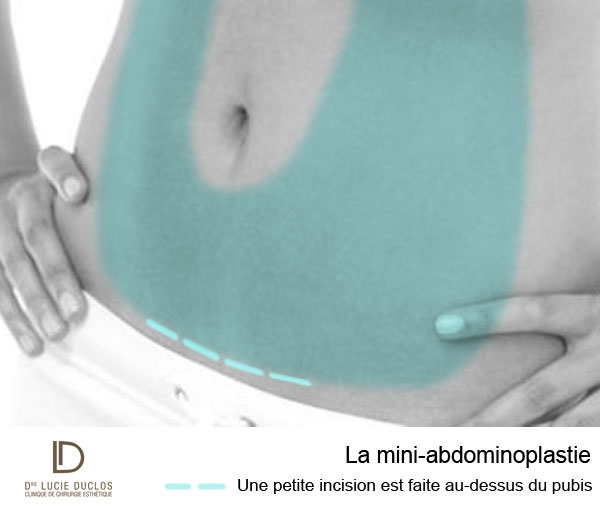The mini abdominoplasty is a variation of the classic abdominoplasty. This procedure aims to tighten or rejuvenate the lower abdomen region only. It consists of removing excess skin and fat from the suprapubic region (below the navel).
The advantage of a mini abdominoplasty is that the incision is made very low on the abdomen, just above the pubis, which means that the scar is very discreet and easily concealed by clothing.
The mini abdominoplasty, like the classic abdominoplasty, acts on three anatomical levels:
- on the skin, removing excess.
- on fat by refining the thickness of the abdominal wall through liposuction
- on the muscles by tightening the abdominal muscles
Mini abdominoplasty is usually performed when the main problem is excess skin, although there may also be excess fat.
Mini abdominoplasty is indicated when there is:
- excess skin below the navel, but no or minor excess skin above the navel.
- muscle relaxation predominant below the navel, but muscle relaxation absent or barely rising a few centimeters above the navel.
If the excess skin and sagging are located above the navel, then a classic abdominoplasty should be used.
Who can benefit from a mini abdominoplasty?
Anyone who suffers from a sagging lower abdomen:
- Women after childbirth
It is common for some women that the skin of the lower abdomen is no longer able to contract to return to its pre-pregnancy state and remains distended despite diets or physical exercises. - The formerly obese
It often happens that the skin becomes loose following weight loss. If it is mainly under the navel, the mini abdominoplasty can be useful. - Elderly people
The mini abdominoplasty helps correct sagging skin and muscles due to aging.

Classic abdominoplasty or mini abdominoplasty?
Sagging skin rarely occurs only under the navel. This is why the mini abdominoplasty is much less frequently performed than the classic abdominoplasty.
In the mini abdominoplasty, the peeling of the skin only concerns the skin below the navel and does not go beyond, whereas in the abdominoplasty, the peeling of the skin goes up to the ribs and the sternum.
In the mini abdominoplasty, the navel may be slightly lowered. There will be no scarring around the navel unless muscle tightening above the navel is performed.
If the scar is slightly shorter in the mini abdominoplasty, this does not mean that the mini abdominoplasty only leaves a mini scar.
The results of the mini abdominoplasty
The post-operative aftermath is simple. The definitive result is obtained three months after the operation, when the edema has disappeared.
It is rare that the placement of a drain is necessary because the internal sutures between the fat and the muscle speed up the healing process. If a drain is placed, it is generally removed the day after the procedure.
You should know that in men the hair at the excision site will be thinning after surgery.
Before the procedure
It is recommended to stop:
Tobacco consumption at least 2 weeks before and after surgery. Nicotine prevents oxygenation of the skin and other tissues and can contribute to tissue necrosis.
Taking aspirin or anti-inflammatories two weeks before and after the procedure. Anti-inflammatories and aspirin thin the blood and can cause significant bleeding during or after surgery. Acetaminophen (Tylenol) is safe to use.
Alcohol consumption in all its forms three weeks before and two weeks after surgery. Alcohol can cause bleeding during or after surgery.
The intervention
The mini abdominoplasty is performed under light general anesthesia.
It generally lasts 1h15 to 1h45.
An incision is made above the pubis and the skin is raised to above the navel on each side. The navel remains intact, no incision is made there. If the muscles under the skin show laxity or diastasis (separation), they will be tightened or brought together with stitches.
The excess skin is pulled down, and the amount to be removed is then determined. The incision is closed with stitches under and in the skin that leave fewer marks. Sutures on the skin are avoided whenever possible. Then a light dressing is applied.
After the intervention
The threads are absorbable.
A compression garment or abdominal girdle must be worn throughout the healing period, which is approximately one month.
You should also avoid activities that can raise blood pressure such as cleaning, vacuuming, leaning your head forward, washing the bathtub, lifting heavy objects, etc.
Physical activities can usually be resumed one month after surgery.
It takes about three months for the final result.
Possible complications
Decreased sensitivity in the skin
Skin that has been peeled off to be tightened may lose its sensitivity. This will in principle return after six months, but it may happen that the reduction in sensitivity is permanent.
Necrosis (tissue loss) (rare)
This problem is often caused by nicotine. Also an infection or accumulation of fluid under the newly stretched skin can cause tissue necrosis.
Poor healing
Everyone heals differently. In some rare cases, the scars enlarge and become more visible.

